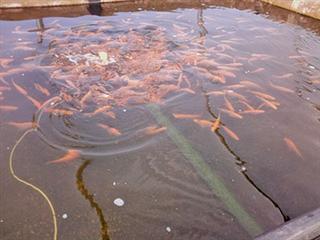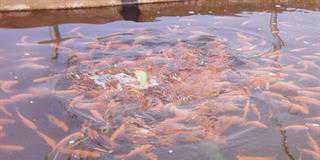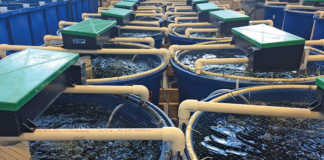
Commercial tilapia feeds are formulated, cooked, extruded and pelletised diets typically containing 32% to 40% protein. This can be fish meal or soya-based protein, with the former being more palatable to the fish. The question of palatability is important – and one frequently overlooked by nutritionists, feed manufacturers and fish farmers themselves.
Floating pellets are usually recommended, as they remain on the surface until consumed. They are, however, more expensive. Pellets designed to sink are simpler to manufacture and are therefore cheaper. But they can get lost in the bottom mud of ponds. This is not a problem in shallow, artificial containments, though, as the fish can find pellets that have sunk to the tank floor.
In practice, many locally made pellets that are designed to float end up sinking immediately! Vitamin C is an important ingredient and should not be omitted from the pellet formulation. If it is, it should be provided in some form by supplemental feeding. In any re-circulating system, the water cannot be fertilised as it is in earth-pond culture. The process is often misunderstood. Pond water is fertilised using animal manure to increase the natural productivity of food organisms.
The fish do not eat the manure. Instead, it breaks down in the water, and the natural populations of zooplankton (microscopic animals) and phytoplankton (micro-algae) are boosted to provide abundant food for the fish. Do this in a closed system, however, and you run the risk of oxygen depletion and ammonia enrichment – a potentially deadly combination in the confined space of a re-circulating system.
Examples of commercially available tilapia feeds (4mm and 5mm pellets are also available).

FRY Fingerling 60mm to 120mm
Duckweed: yes or no?
A number of supplemental feeds can – and should – be fed to tilapia. They decrease costs and increase fish health.
Duckweed is often mentioned in this context, as it is relatively high in protein, rich in Vitamin C and provides roughage. The problem with duckweed is that it competes with the fish for tank space. In addition, it should never be allowed to escape into natural waters, or even farm dams, as it is an invasive alien plant that can rapidly degrade or even totally smother water bodies.
Earthworms and lucerne
Only one kind of fish won’t eat an earthworm: a dead one! Earthworms are an excellent supplemental feed, with an estimated 60% protein content. Raising earthworms (the small red variety) is easy, especially if there’s a ready supply of dry manure. Unfortunately, you will need to harvest many kilograms of worms daily to provide your fish with enough, so small-scale worm culture is hardly worthwhile.
Tilapia, unlike terrestrial animals, can digest freshly cut green lucerne without suffering bloat. This excellent crop, which is high in protein, vitamins and minerals, is also economical as it can be cut repeatedly. It’s especially favoured by Tilapia rendalli. Chicken farmers often ask me if they can feed fish on maggots grown on waste products. I have reservations about this, as the white maggots are sure to have a very high fat content, something that tilapia digestive systems may struggle to cope with. This would form an interesting research topic.













